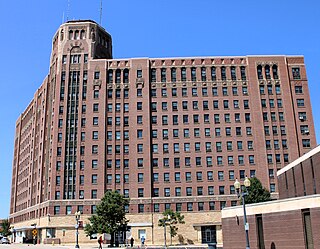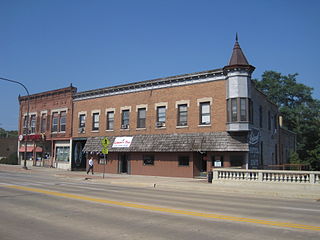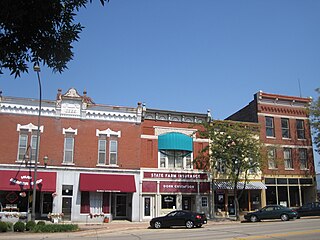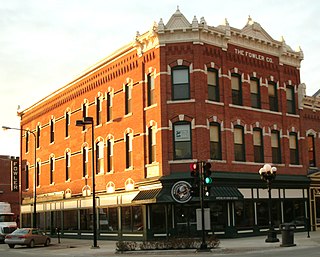
Galena is the largest city in and the county seat of Jo Daviess County, Illinois, with a population of 3,308 at the 2020 census. A 581-acre (235 ha) section of the city is listed on the National Register of Historic Places as the Galena Historic District. The city is named for the mineral galena, which was in the ore that formed the basis for the region's early lead mining economy.

Orangeville is a village in Stephenson County, Illinois, United States. The town's sign lists the population at 800 as of January 2021. The population in 2020 was 738. The population according to the 2010 census was 793, up from 751 in 2000. Using the 2020 population of 738 Orangeville is the 741st largest city in Illinois and the 11,650th largest city in the United States. Orangeville is currently declining at a rate of -0.94% annually and its population has decreased by -6.94% since the 2010 census. The area's earliest white settlers arrived in the year 1833, and the village was platted in 1851 by John Bower, who is considered the village founder. In 1867 Orangeville was incorporated as a village. The town's central business district contains several 19th century commercial buildings, many of which were built during the railroad boom of 1888–1914. By the time the Great Depression was ongoing, business in Orangeville had started to decline, with the last bank closing in 1932. In 1956 another bank started operating in the village and is still in town today. Some recent infrastructure jumps have restored some of the village's old decor.

Rockford is a city in Winnebago County, Illinois, United States. It is located in the far northern part of the state on the banks of the Rock River. Rockford is the fifth-most populous city in Illinois as well as the most populous outside of the Chicago metropolitan area and the 171st-most populous in the U.S. In the 2020 census, Rockford had a population of 148,655 anchoring the Rockford metropolitan area with a population of 348,360. Rockford is the county seat of Winnebago County, while a small portion of the city is located in Ogle County.

The Faust Landmark, formerly known as the Faust Hotel and Tebala Towers, is located on East State Street, is one of the largest buildings in downtown Rockford, Illinois, United States. It currently serves persons 55 years and older. Built in 1929 as a hotel, it was sold to the Shriners who renamed it Tebala Towers. It was renamed to its current name when sold by the Shriners and was renovated into one and two bedroom efficiency apartments.
Indianapolis has seven designated neighborhoods as Cultural Districts, first established in 1999: Broad Ripple Village; Mass Ave; Fountain Square; Wholesale District; Canal and White River State Park; Indiana Avenue; and Market East. The purpose of these designations was to capitalize on cultural institutions within historically significant neighborhoods unique to the city's heritage for economic development and revitalization.
Los Angeles Street, originally known as Calle de los Negros is a major thoroughfare in Downtown Los Angeles, California, dating back to the origins of the city as the Pueblo de Los Ángeles.

The Chick House is a former hotel building constructed in 1857 in the city of Rockford, Illinois, United States. The building's construction was financed by three Rockford citizens and it operated as a hotel from its opening until 1951. The hotel was purchased by Thomas Chick in 1888 and he renamed it from the Griggs House to the Chick House. In 2004 the city of Rockford purchased two-thirds of the building and made some modifications to the structure. The building is a mesh between the Greek Revival and Italianate styles and feature simple ornamentation that contrasts with a neighboring building. The Chick House is a Rockford Landmark and was listed on the U.S. National Register of Historic Places in 1997.

The Galena Historic District is a historic district located in the city of Galena, Illinois, United States. The historic district encompasses 85 percent of the city of Galena and includes more than 800 properties. The downtown area consists of three successive tiers made up of Main, Bench and Prospect Streets. Within the boundaries of the district are such notable homes as the Ulysses S. Grant Home and the Elihu B. Washburne House. The Galena Historic District was added to the U.S. National Register of Historic Places in 1969.
The Galena–Chicago trail was a stagecoach route located in northern Illinois that ran from the mid-to-late 1830s until 1854. As indicated by its name, the route linked Chicago, located in the northeast of the state, with Galena which was located in the lead mining district of the northwest. The Chicago-Galena trail includes the "Stagecoach Trail" that runs between Galena and Lena, Illinois. East of Lena the stage route follows U.S. Route 20 and Business U.S. Route 20 through Eleroy, Freeport and Rockford to Belvidere. This road began as the old State Road number 2 established on 15 January 1836 and laid out by June 1837.

Stolp Island is a small island in the Fox River in Aurora, Illinois. In 1986 the island and its 41 buildings were added to the National Register of Historic Places as the Stolp Island Historic District. It covers 0.03 square miles (0.1 km2) of land area.

West Third Street Historic District is located on the west side of downtown Davenport, Iowa, United States. It was listed on the National Register of Historic Places in 1983. The historic district connects the central business district with the working-class neighborhoods of the West End. Its historical significance is its connection to Davenport's German-American community. Germans were the largest ethnic group to settle in Davenport.

The Downtown Waterbury Historic District is the core of the city of Waterbury, Connecticut, United States. It is a roughly rectangular area centered on West Main Street and Waterbury Green, the remnant of the original town commons, which has been called "one of the most attractive downtown parks in New England."

The Belvidere North State Street Historic District is a historic district on the north side of the Kishwaukee River in Belvidere, Illinois. It is primarily composed of commercial building representative of architectural trends from 1865 to 1962. The district has remained largely intact since the mid-1930s.

The Belvidere South State Street Historic District is a historic district on the north side of the Kishwaukee River in Belvidere, Illinois. It is primarily composed of commercial building representative of architectural trends from 1852 to 1962, the period following the connection of the city to the Galena and Chicago Union Railroad.
John Edmund Oldaker Pridmore was a British-American architect, best known for his theater designs. He lived in Edgewater, Chicago and carried out many residential designs in the area. Pridmore was the architect for three homes he lived in at 6249 N. Magnolia, four years later he designed a larger house at 5959 North Winthrop where he spent the majority of his professional and family life, and then an apartment in the building at 6003 N. Winthrop, to the north of his house.

The West Downtown Rockford Historic District is a set of forty-four buildings in Rockford, Illinois, United States that reflect the downtown district of the city west of the Rock River. Of these buildings, forty-one contribute to the historical significance of the district.

The William Brown Building is a historic commercial building in Rockford, Illinois, United States. Completed in 1892, it is considered a fine local example of Romanesque Revival architecture. It was one of the last major commercial buildings in Rockford between the Panic of 1893 and the Roaring Twenties.

The Fowler Company Building is a historic building located in Waterloo, Iowa, United States. It was built in 1884 by the city's most successful grocery wholesale business. They continued to operate from here until 1937. The three-story brick structure is an example of Late Victorian commercial architecture with Queen Anne influences. The building features pilasters, corbeling, canted-brick courses, and contrasting stone trim around and between the windows and at the street level. It is capped with an ornate metal cornice that contains pilasters, finials, pediments, floral and circle imagery, and quilted surface textures. It was individually listed on the National Register of Historic Places in 2009. In 2011 it was included as a contributing property in the Waterloo East Commercial Historic District.

















